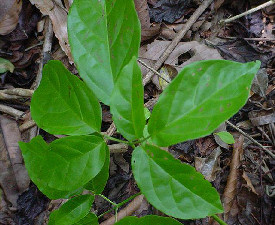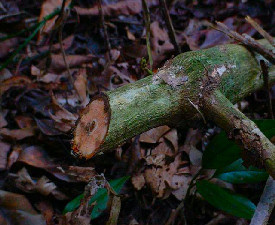Overview
 Curare (Strychnos guianensis) is a climbing woody vine (liana) growing in the
Amazon rainforest.
Curare (Strychnos guianensis) is a climbing woody vine (liana) growing in the
Amazon rainforest.
The curare (the main poison) is obtained from the bark of this liana. It works by affecting neuromuscular
transmissions. It is basically a natural muscle relaxant; causes death by paralyzing the respiratory
system of primates, resulting in asphyxiation.
Used by the Amerindians as an arrow poison together with other plants that speed up the heartbeat.
The animal, shot with an arrow, of which the point is dipped in the poison, remains alert throughout the whole
process.
However, the bark is also a potent natural sedative and can be used in the treatment of convulsive and
spasmodic disorders, when applied by a trained herbalist or homeopath.
Constituents
Alkaloid D-tubocurarine, mono- and bisindole quaternary alkaloids: Guiaflavine,
5',6'-dehydroguiaflavine, 9-methoxy-Nb-methylgeissoschizol;
C-alkaloid O, fluorocurine, mavacurine, macusine B
and C-profluorocurine.
Pharmacology
Mono- and bisindole quaternary alkaloids isolated from the stem bark of Strychnos
guianensis have been shown to be effective blockers of neuromuscular transmission in mice. A human clonal
cell line (TE671) expressing muscle-type nicotinic acetylcholine receptors. The agonist carbamylcholine activated
a receptor-mediated 86Rb+ efflux and this activation was antagonized by the indole alkaloids, the most active
being bisindole bisquaternary compounds. The most effective antagonist, guiachrysine, had an IC50 around
0.43 µM in the presence of 0.5 mM carbamylcholine, compared to 0.16 µM for d-tubocurarine, the most
potent curarizing alkaloid. Guiaflavine and 5',6'-dehydroguiaflavine were slightly less effective. Monoindole
compounds were 10 to 100 times less potent than bisindole alkaloids.
Dosage
Tincture: check with your herbalist or homeopath
Warning
May be extremely poisonous!
 Reference
Reference
Foldes, F.F. "Anesthesia before and after curare", Anasthesieabteilung des
Albert-Einstein-College of Medicine.
Anaesthesiol Reanim, 1993, 18(5):128-31. (retrieved June 20 2005) James, Mel. "Harold Griffith",Heirloom
Series, Volume 6. (retrieved June 20 2005)
"Curare", Blue Planet Biomes, 2000. (retrieved September 27 2005)
Bisindole alkaloids from Strychnos
guianensis are effective antagonists of nicotinic acetylcholine receptors in cultured human TE671 cells.
Wins P, Margineanu I, Penelle J, Angenot L, Grisar T, Bettendorff L.
Center for Cellular and Molecular
Neurobiology, University of Liege, place Delcour, 17, 4020 Liege, Belgium
Quaternary indole alkaloids from
the stem bark of Strychnos guianensis.
Penelle J, Tits M, Christen P, Molgo J, Brandt V, Frederich M, Angenot L.
Universite de Liege, Institut de
Pharmacie, CHU, Belgium. jacques.penelle@ulg.ac.be
The above presentation is for informational and educational purposes only.
It is based on scientific studies (human, animal, or in vitro), clinical experience, or traditional usage.
For many of the conditions discussed, treatment with prescribed (RX) or over - the - counter (OTC) medication is also
available.
Consult your doctor, practitioner, and/or pharmacist for any health problem and before using
dietary supplements or before making any changes in prescribed medications.
|

